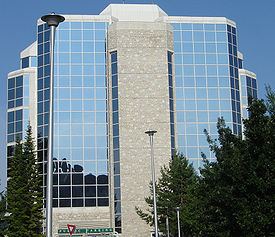Established 1909 Founded 1909 | Endowment $38 M annually Number of students 1,000 Dean Graham Scoles Dean Mary M. Buhr | |
 | ||
Administrative staff 350 faculty, research scientists, administrative & support staff. Undergraduates diploma, degree available Postgraduates postgraduate level degree available Similar University of Saskatchewan, Horizon College and Semi, Ontario Agricultural College, Saskatchewan Polytechnic, Parkland College | ||
The College of Agriculture and Bioresources is a faculty at the University of Saskatchewan in Saskatoon, Saskatchewan.
Contents
- History
- Buildings and Features
- Programs
- Beamish Conservatory
- Kenderdine Art Gallery
- Kloppenburg Collection
- Leo Kristjanson Atrium
- Agricultural Displays
- References
It has an annual budget of $38 million and an enrolment of approximately 1,000 students studying at the diploma, undergraduate degree, graduate degree and postgraduate levels. The College has approximately 350 employees, including faculty, research scientists, administrative and scientific support staff.
History
The University of Saskatchewan established its College of Agriculture in 1909. Between 1914 and 1922 the College teamed up with the Saskatchewan Department of Agriculture to operate the Better Farming Train throughout rural Saskatchewan.
The University Council approved a change of the name of the College to "College of Agriculture and Bioresources" in June 2005.
Buildings and Features
The Agriculture Building and contents represent an investment in excess of $100 million. There are 18,000 square metres of usable space, consisting of 180 research labs, 38 teaching labs, 212 staff offices, 10 classrooms, 4 computer classrooms and 7 conference rooms. There are 7 building levels, including an underground parkade and 3 building wings. There are also pedestrian walkways to Engineering (east), Anthropology (south), Biology (west) and Kirk Hall (south).
The Agriculture Building and contents comprise 18,000 square metres of usable space, consisting of 180 research labs, 38 teaching labs, 212 staff offices, 10 classrooms, 4 computer classrooms and 7 conference rooms. There are 7 building levels, including an underground parkade and 3 building wings. There are also pedestrian walkways to Engineering (east), Anthropology (south), Biology (west) and Kirk Hall (south).
Agriculture and Bioresources College held its first classes in the College Building There were also 1,000 acres (405 ha) reserved for agriculture practice, University Barn, crops, and livestock study. The new Agriculture building built between the years of 1988 and 1991 was a large 6 storey glass building, with a seventh floor addition in the year 2000. The National Research Council contributed to the establishment of a Crop Development Centre at the University of Saskatchewan Courses would be offered in the following fields Agricultural and Bioresource Engineering (ABE), Agricultural Economics (AGEC), Agriculture (AGRC), Agronomy (AGRN), Animal Science (ANSC), Environmental Science (EVSC), Food and Applied Microbiological Sciences (FAMS), Indigenous People Resource Management (IPRM), Large Animal Clinical Sciences (VLAC), Plant Sciences (PLSC), and Soil Science (SLSC).
Programs
The Agriculture & Bioresources College programs at the University of Saskatchewan include:
Beamish Conservatory
The Beamish Conservatory (Atrium) is named in honour of the donor May Beamish daughter of artist Augustus Kenderdine. The atrium is located in the College of Agriculture and Bioresources building.
Kenderdine Art Gallery
Kenderdine Art Gallery celebrated its official opening October 25, 1991. Augustus Frederick Lafosse (Gus) Kenderdine began the University Art Camp at Emma Lake in 1936, the precursor to the Emma Lake Kenderdine Campus, a bequest was donated to the University of Saskatchewan by his daughter, Mrs. May Beamish, and initialized the formation of the Kenderdine Art Gallery which has a permanent collection started by Dr. Murray, as well as ongoing exhibits.
Kloppenburg Collection
The Kloppenburg Collection is featured on the 6th floor of the College of Agriculture and Bioresources building which opened in 1991. 27 works by famous Saskatchewan artists are featured in this donation to the University of Saskatchewan. The art forming the Kloppenburg College of the College of Agriculture and Bioresources was donated by Henry R Kloppenburg QC, a Saskatchewan Rhodes Scholar, and Cheryl L Kloppenburg. They are well known art collectors and patrons of the arts in Saskatchewan. They are practicing lawyers in Saskatoon, Saskatchewan with a longtime interest in the arts and agriculture.
Leo Kristjanson Atrium
This atrium is named in honour of Leo F. Krisjanson, President of the University of Saskatchewan, 1980-1989.
Agricultural Displays
The agricultural wall displays are located in the walkway connecting the Agriculture Building and the Biology Building.
